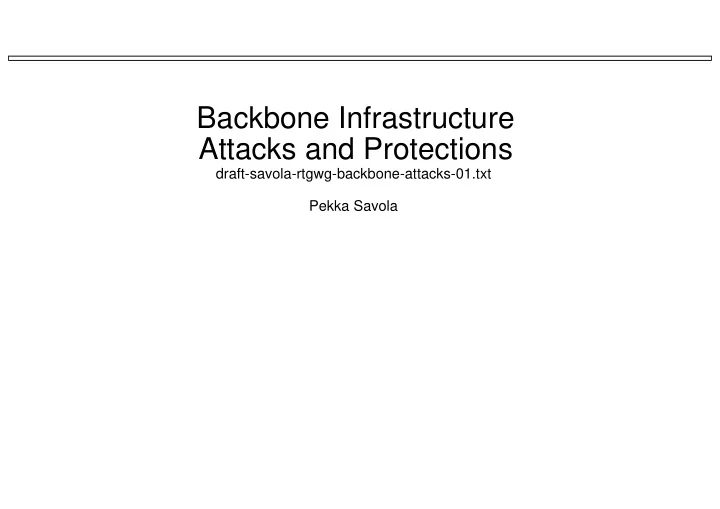

Backbone Infrastructure Attacks and Protections draft-savola-rtgwg-backbone-attacks-01.txt Pekka Savola
Introduction Describes a view of ISP backbone network attacks Lots of folks in IETF and elsewhere had quite different ideas what’s out there Particularly on.. The need for TCP-MD5 Ingress/egress filtering at borders This very operational document tries to harmonize that view Administrativia It is not clear what is the right home for this RPSEC? OPSEC? Invididual? Drop?
Document structure Scope Backbone infra and critical protocols required to function for legitimate traffic to be correctly forwarded Out of scope e.g., AAA, NTP, syslog, SNMP, DNS, ... Assumptions and threat model Typical attack vectors Countermeasures Protocol analysis how countermeasures apply to the attack vectors
Assumption and threat model Assumption SP is doing at least some filtering at the borders So that no one can spoof infrastructure addresses Threat model focused on external attacks, e.g., DoS attacks directed at infrastructure DoS attacks directed at whoever but cause harm to infrastructure Infrastructure access hijacking attemps Out of scope, e.g., Lower-layer attacks (e.g., MITM insertion on a fiber) Insider attacks or router compromise Likely detected by change management etc.
Typical attack vectors Lower-layer attacks Physical link security is typically not an issue Generic DoS on the Router E.g., sending hop-by-hop options that get punted to slow-path Generic DoS on a Link Cryptographic Exhaustion E.g., TCP/MD5 or control-plane IPsec attacks Unauthorized Neighbor or Routing E.g., careless IGP configuration or BGP filtering TCP RST Attacks ICMP Attack Even worse than TCP RST attacks
Typical countermeasures Filtering addresses in packets Ingress filtering your own blocks assumed Egress filtering that allows only your own addresses recommended Filtering addresses in routing updates, e.g., Filter out your own routes and more specifics Define maximum prefix limits to avoid de-aggregation GTSM Deploy on eBGP sessions as 1st order protection GTSMbis spec should say define TCP-RST TTL handling TCP-MD5 and other custom authentication IPsec and IKE Heavyweight, not well supported, difficult to configure
Protocol Analysis (1/2) ICMP attacks apply to all the protocols :-( OSPF Config audits to prevent unauthorized neighbors OSPF protocol needs to be blocked at borders IS-IS Config audits to prevent unauthorized neighbors BFD Uses GTSM so OK
Protocol Analysis (2/2) BGP iBGP requires no protection (spoofing protection enough) eBGP with GTSM is typically good enough single-homed customers require no protection multi-homed customers a bit trickier, depends on whose p2p addresses used upstream may use TCP-MD5 but only upstream could reset IX peering fabrics should probably use TCP-MD5 Content security (routing update verification) a SIDR topic LDP Removed due to lack of experience Multicast protocols (PIM-SM, MSDP, etc.) draft-ietf-mboned-mroutesec draft-savola-pim-lasthop-threats Bottom line: vendor-specific rate-limiters etc.
Summary Protecting IGP is rather straightforward Protecting BGP transport is relatively easy with filtering and GTSM TCP-MD5 just reduces the attack vector Threats and necessity of TCP-MD5 seem overemphasized Various router DoS attacks require vendor-specific rate-limiting etc. Open issues for the IETF ICMP attacks against non-TCP protocols E.g., IPsec’s by-default ICMP handling is underspecified SCTP, DCCP, UDP, ... GTSM TCP-RST clarification wrt TTL
Recommend
More recommend